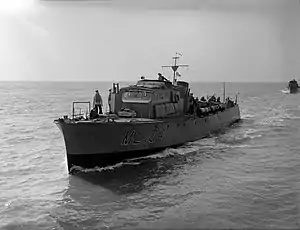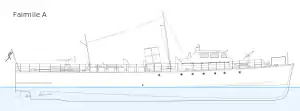Fairmile A motor launch
The Fairmile A motor launch was a coastal motor launch designed by Norman Hart for the Fairmile Marine for the Royal Navy in World War II. The prototype ML 100 was privately built by the British industrialist Noel Macklin, who placed an order for this craft on 27 July 1939 with Woodnut's boatyard at St Helens. The Admiralty placed an order for a series of boats to this design on 22 September, including the prototype under construction. The twelve boats completed to this initial design were numbered ML 100 to ML 111.
 The Fairmile A motor launch ML104 carrying depth charges as an A/S escort or sub-chaser in 1941 at Dover, England | |
| Class overview | |
|---|---|
| Name | Fairmile A motor launch |
| Succeeded by | Fairmile B motor launch |
| Completed | 12, numbered from ML100 to ML111 |
| Lost | 4 |
| Retired | 8 |
| General characteristics | |
| Displacement | 57 tons, not including armament and equipment |
| Length | 110 ft (34 m) |
| Beam | 17 ft 5 in (5.31 m) |
| Draught | 4 ft 6 in (1.37 m) forward, 6 ft 6 in (1.98 m) aft |
| Propulsion | 3 Hall-Scott Defender V12 petrol engines 600 hp |
| Speed | 25 knots (46 km/h; 29 mph) at 2,200 rpm |
| Range | 600 mi (520 nmi; 970 km) at 12 knots (22 km/h; 14 mph) |
| Complement | 16, including 2 officers |
| Sensors and processing systems | ASDIC |
| Armament | one QF 3 pounder Hotchkiss gun
one pair of 0.303 in. Lewis machine guns 12 depth charges |
Development
Shortly before the Second World War the British industrialist Noel Macklin submitted to the Admiralty an innovative plan for the series production of a motor launch (vessels for harbour defence and submarine chasing). The design used prefabricated parts, which allowed various small concerns, such as furniture and piano manufacturers,[1] to produce the individual components. These components could then be assembled in separate shipyards. The hull was to be made of plywood frames divided into nine watertight compartments, with double diagonal mahogany planking forming the outer skin.
The final design was a 110-foot, hard-chine boat of planing form, optimised for speed at the expense of range as befitted the intended coastal sub-chaser role, although the turning circle would be larger than hoped for as a result of the hard chines. The cabin was located well forward, leaving a large working space aft for the handling of depth charges and guns. The Admiralty rejected the concept, and so the prototype was built as a private venture. In July 1939, two months before the outbreak of war, the Admiralty had a change of heart and purchased the prototype. Following the outbreak of war, they awarded Macklin's Fairmile Marine company a contract on 22 September to have built twenty-four further Type A Fairmiles, using a variety of separate shipyards. While these launches were on order, an improved Type B design came from Bill Holt, head of the Admiralty's DNC Boat Section. The hard-chine hull of the Type A had exhibited seakeeping and handling limitations, but Holt's round-bilged design for the Type B was a far more seaworthy form. Thus Fairmile was instructed to complete the last thirteen of the order (ML 112 to ML 124) to the new variant design, so that only twelve Type A (including the prototype) were completed.
Boats
| Name | Ship Builder | Completed | Fate |
|---|---|---|---|
| ML 100 | Woodnutt & Co., St Helens, Isle of Wight | 19 May 1940 | Sold in October 1947. |
| ML 101 | James A. Silver, Rosneath, Dumbartonshire | 28 May 1940 | Sold in November 1947 as Firebird. |
| ML 102 | Woodnutt & Co., St Helens, Isle of Wight | 15 June 1940 | Sold in August 1947 as yacht Carlyle. |
| ML 103 | Brooke Marine, Oulton Broad, Lowestoft | 28 June 1940 | Sunk by mine 24 August 1942 in the Dover Straits. |
| ML 104 | A. M. Dickie & Sons, Bangor, Gwynedd | 28 June 1940 | Sold in 1947. |
| ML 105 | Frank Curtis, Looe, Cornwall | 8 July 1940 | Sold in May 1946. |
| ML 106 | Alex Robertson (Yachtbuilders) & Sons, Sandbank, Argyll | 5 July 1940 | Sold in January 1947. |
| ML 107 | Sussex Shipbuilding, Shoreham-by-Sea, Sussex | 30 June 1940 | Sold in August 1947. |
| ML 108 | James N. Miller & Sons, East Shore, St Monance, Fife | 4 July 1940 | Sunk by mine 5 September 1943 in the Channel. |
| ML 109 | William Osbourne, Littlehampton, Sussex | 1 August 1940 | Sunk by mine 30 October 1940 off the Humber. |
| ML 110 | Aldous Successors, The Shipyard, Brightlingsea | 24 July 1940 | Sold in August 1947. |
| ML 111 | James A. Silver, Rosneath, Dumbartonshire | 27 July 1940 | Sunk by mine 25 November 1940 off the Humber. |
Service

The first vessel (ML100) was not completed until May 1940 because of handling problems at low speeds, although the subsequent boats had all entered service by July.[2] Their role was to be anti-submarine escorts in coastal waters, but, once the better Fairmile B motor launches began to enter service in the autumn of 1940, the Type A boats were converted to minelayers.[3]
See also
References
- Mullard Heals and Parker Knoll are among those named. The subdivision of the work outside traditional boat builders was part of an agreement not to make demands on the usual suppliers to the Admiralty
- Angus Konstam, British Motor Gun Boat 1939-45 Osprey Publishing Limited 2010, ISBN 978-1-84908-077-4 (pp.12-14)
- Konstam (p.15)
- Norman Friedman, British Coastal Forces: Two World Wars and After 2023, Seaforth Publishing ISBN 978-1-3990-1858-6
- John Lambert and Al Ross, Allied Coastal Forces of World War Two, Volume I : Fairmile designs and US Submarine Chasers 1990, Conway Maritime Press ISBN 978-0-85177-519-7
- A. J. D. North, Royal Naval Coastal Forces 1939-1945 1972, Almark Publishing Co. ISBN 0-85524-069-6 Parameter error in {{ISBN}}: checksum